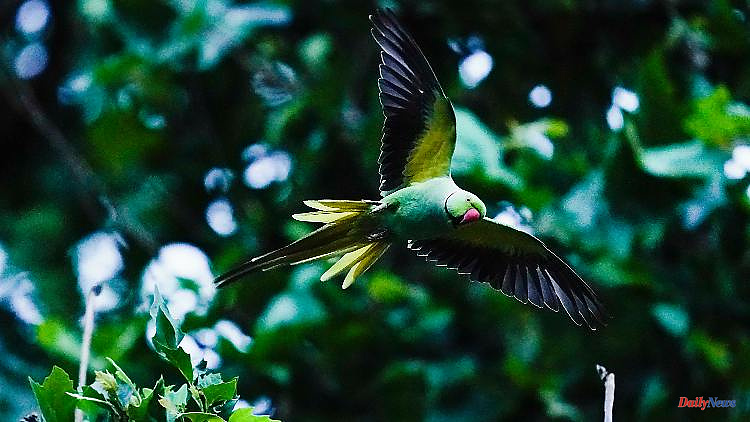Big old trees full of parrots, that's a quite familiar sight in Cologne, Dusseldorf, Heidelberg and Stuttgart. Some are excited about it, others just annoyed.
They are bright spots in the urban bird world: Green and yellow parrots have found their way into many large cities in Germany. The biologist Michael Braun estimates the population of ring-necked parakeets with their bright green plumage and the black collar of the males at 20,000 specimens. "The exotics have found a free ecological niche for themselves," explains Braun, who is scientifically involved with Alexandrinus manillensis. The birds have found optimal living conditions on the Rhine in particular.
Ironically, trees on the posh Kö in Düsseldorf have chosen the birds as a place to sleep - much to the displeasure of the retailers. They are a tourist attraction on Cologne's Rhine promenade. "People feel like they're in the Amazon forest," says Horst Bertram, head of the Cologne Nature Conservation Union (NABU). In Heidelberg, travelers are greeted in the evening in front of the main train station by the screeching of around 1,000 specimens on their sleeping trees at one of the city's largest intersections. And in Stuttgart, Yellow-headed Amazons look for food in the inner-city Rosenstein Park.
"It's even warmer in the cities than in the surrounding area," says Braun, who studied the Heidelberg group. The phenomenon is not limited to Germany, parrots are now also at home in other Central European countries and southern Europe. The ring-necked parakeet has spread from its native India to Southeast Asia and South America and is now the world's most common parrot species, says conservationist Bertram. "The ring-necked parakeet is like the new sparrow."
The origins of the German populations go back decades. "In the 1960s and 1970s there was a parrot hype in Germany," says Bertram. Keeping parrots was a common hobby back then. Specimens that escaped from captivity formed the basis for the individual stocks. This was also the case in Stuttgart, where the only German group of Yellow-headed Amazons can be found.
"Back then, bird lovers collected to buy a mate for an escaped male," says Bianca Horn, a long-time observer of the 60 parrots. From the connection at that time, three young birds were born in 1986 and gave new impetus to a species that is almost extinct in its Central American homeland. According to the Federal Government for the Environment and Nature Conservation, there are only 3,500 specimens left there.
The photographer has been devoting her free time to birds and their social behavior for seven years. She found that the animals are monogamous. But if a male loses his mate, do whatever it takes to steal the female from another. "Parrots don't like to be alone," the 50-year-old noted. Even the young birds learned these pair-finding struggles in a playful way.
The hobby ornithologist is currently worried about her favorite bird, Rodolfo. Its mate has already laid her eggs in a brood cavity, but the mate has disappeared and is unlikely to be able to help her in the 24 days to hatch or with the first flight of the young at two months. Rodolfo could have been hit by a bird of prey or a car.
How can parrots reside in places thousands of miles from their natural habitat? The strong, crooked beak is the key to their survival, says expert Braun. This means that the immigrants are not dependent on grains and can crack walnuts and hazelnuts like they would with pliers. Berries and fruits are also on the menu for vegetarians, of which there are plenty even in winter thanks to exotic plants such as the trumpet tree.
Unlike the Egyptian geese, the parrots do not spread very much. "They stay true to one place," says biologist Braun. They don't even think of flying to warmer climes in winter. The tropical birds can cope with low temperatures, albeit sometimes with frostbite on their claws. Parrots are not an invasive species that displace native animals. They only compete with jackdaws, woodpeckers and stock pigeons when looking for nesting holes in old trees.
Coexistence between humans and animals is not entirely free of conflict. In 2003, parrots nested in the thermal insulation of a retirement home in Heidelberg. Incubators solved the problem.
In Cologne, they wanted to appoint a "deterrent officer" to scare the animals away after residents of sleeping trees complained about the noise and droppings of the 3,000 Cologne birds. A beer garden operator was particularly affected, whose awning was soiled by parrots every day. The birds moved 50 meters further into trees in front of a hotel, whose guests are now enjoying the hustle and bustle. "A stroke of luck," says Bertram. So the "deterrent officer" didn't have to move out with noise, lights and dummy birds of prey. In nearby Düsseldorf, there was even talk of driving the parakeets away from the promenade with falcons.
According to Bertram, looking for a common sleeping tree is a primal instinct of the animals, which gives them security. If they were driven away, they would split up into several small groups. "The roost splitting means stress and restlessness for the parakeets." His conclusion: "Then even more people would feel disturbed."












